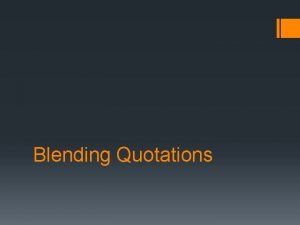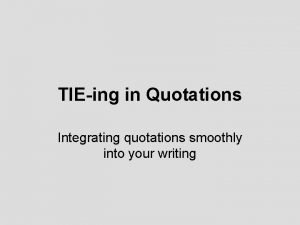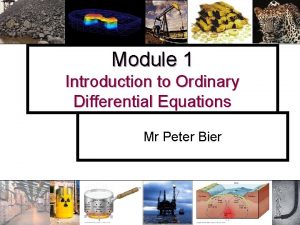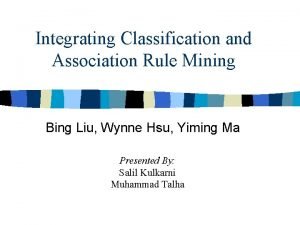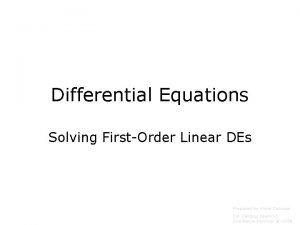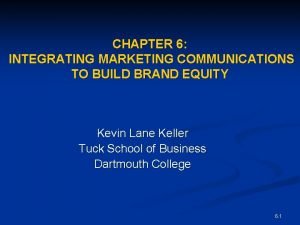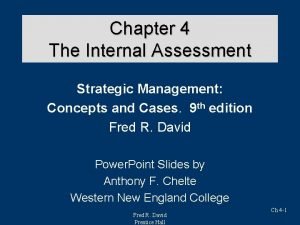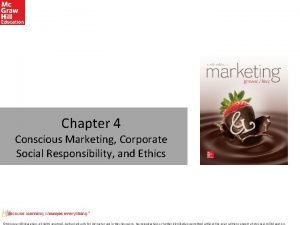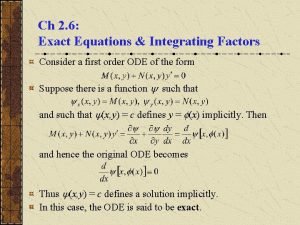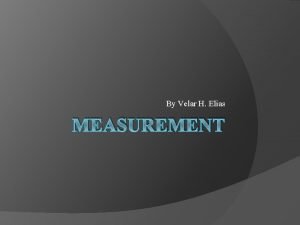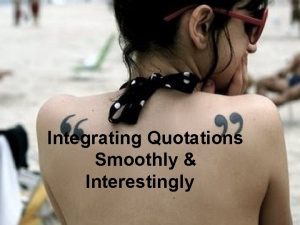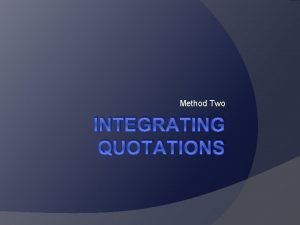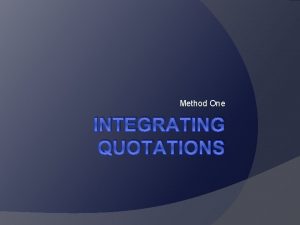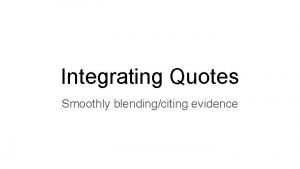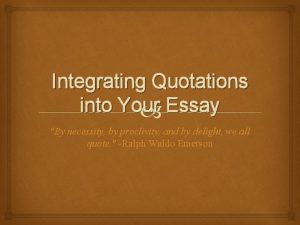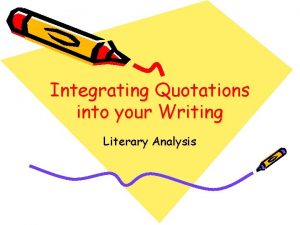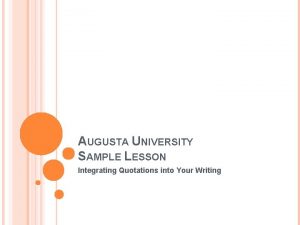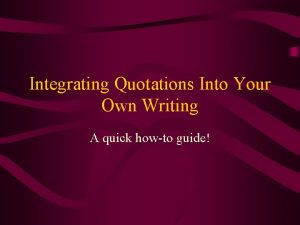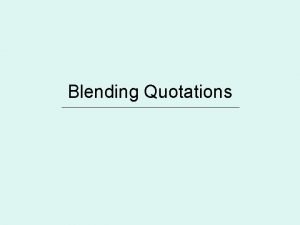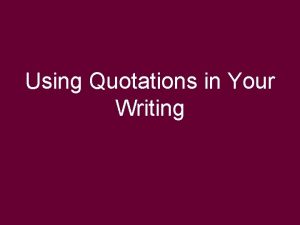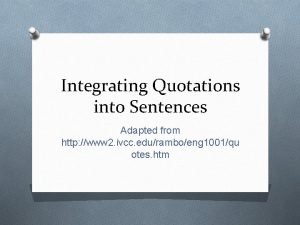TIEing in Quotations Integrating quotations smoothly into your
















- Slides: 16

TIE-ing in Quotations Integrating quotations smoothly into your writing

THE ESSENTIALS • Citation: You must give credit for anything you take from the text: Zaroff states that the ideal quarry “must possess courage, cunning, and above all, it must have reason” (Connell 18). Writer’s Last Name Page Number Punctuation after citation

IN-TEXT CITATION In-text citations: Author-page style • MLA format follows the author-page method of in-text citation. This means that the author's last name and the page number(s) from which the quotation or paraphrase is taken must appear in the text, and a complete reference should appear on your Works Cited page. The author's name may appear either in the sentence itself or in parentheses following the quotation or paraphrase, but the page number(s) should always appear in the parentheses, not in the text of your sentence. For example: Wordsworth stated that Romantic poetry was marked by a "spontaneous overflow of powerful feelings" (263). Romantic poetry is characterized by the "spontaneous overflow of powerful feelings" (Wordsworth 263).

IN-TEXT CITATION In-text citations for print sources with no known author • Place the title in quotation marks if it's a short work (such as an article) or italicize it if it's a longer work (e. g. plays, books, television shows, entire Web sites) and provide a page number if it is available. For Example: We see so many global warming hotspots in North America likely because this region has "more readily accessible climatic data and more comprehensive programs to monitor and study environmental change" ("Impact of Global Warming").

THE ESSENTIALS • Quoted material can never stand alone. You must TIE it in into one sentence: BAD EXAMPLE (NOT TIED IN): Holden is not happy. “You brute, you brute” (Salinger 234). Holden leaves the compound.

THE ESSENTIALS • Quoted material can never stand alone. You must TIE it in: GOOD EXAMPLE (TIED IN): “You brute, you brute” (Salinger 234), Holden mutters as he leaves the compound where he…

THE ESSENTIALS Your T. I. E. must lead in—you must lead your reader into the story by giving the context the quotation comes from: “You brute, you brute” (Salinger 234), Holden mutters as he leaves the compound where he and Ameera have spent many happy hours. Story Context

TAG (1) Begin the sentence with the writer’s words (a quotation) – Citation follows immediately after (2) Finish with your own words

TAG 1. Writer’s words 2. Citation “You brute, you brute” (Salinger 234), Holden mutters as he leaves the compound where he and Ameera have spent many happy hours. 3. Your words

INTRODUCE (1) Begin the sentence with your own words (2) Finish with the writer’s words (a quotation) – Citation follows immediately after

INTRODUCE 1. Your words As Holden leaves the compound where he and Ameera have spent many happy hours, he mutters, “You brute, you brute” (Salinger 234). 3. Citation 2. Writer’s words

EMBED (1) Begin the sentence with your own words (2) Write the writer’s words – Citation follows immediately after (3) Finish with your own words

EMBED 1. Your words 2. Writer’s words Holden mutters, “You brute, you brute” (Salinger 234), as he leaves the compound where he and Ameera have spent many happy hours. 3. Citation 4. Your words

Let’s Review Write answers in your English Journal: 1. What does T. I. E. stand for? 2. Write the order of your words, the citation, author’s words for all three (T, I and E).

Let’s Review 1. Tag Introduce Embed 2. Tag = 1. Writer’s words 2. Citation 3. Your words

Let’s Review Introduce = 1. Your words 2. Writer’s words 3. Citation Embed = 1. 2. 3. 4. Your words Writer’s words Citation Your words
 Blending quotations
Blending quotations Paragraph
Paragraph European weld symbols
European weld symbols Quote integration methods
Quote integration methods Give us your hungry your tired your poor
Give us your hungry your tired your poor Embedded quotes mla examples
Embedded quotes mla examples Sensory
Sensory Integrating factor method
Integrating factor method Integrating classification and association rule mining
Integrating classification and association rule mining Cad integration for dynamics ax
Cad integration for dynamics ax Basic concepts on integrating technology in instruction
Basic concepts on integrating technology in instruction Solution to it
Solution to it Integrating marketing communication to build brand equity
Integrating marketing communication to build brand equity Key internal forces
Key internal forces What are the criteria for being a conscious marketer
What are the criteria for being a conscious marketer Exact equations and integrating factors
Exact equations and integrating factors Integrating type dvm
Integrating type dvm
